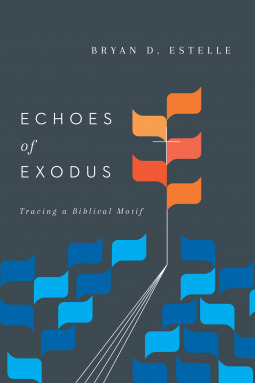Echoes of Exodus, Bryan D. Estelle. Downers Grove: IVP Academic, 2018.
Summary: Traces the exodus motif from creation, through the paradigmatic event, to its later usage, culminating in the pilgrimage of the church as the people of God and the realization of the exodus promises in the new Jerusalem.
The exodus story is a compelling narrative that has shaped the Jewish people, Christians, and particularly peoples in slavery and oppression. It is a story of God raising up a deliverer, demonstrating his power in plagues, leading them out of the land following Passover and the death of Egyptian firstborn, the passage through the Red Sea, where God wars against the Egyptians, the wilderness wanderings, Sinai, testings, and finally after one generation dies, the entry into the land of promise and eventual worship on the mountain of Jerusalem. This story echoes through the pages of scripture, alluded to and transformed as the saving purpose of God works through the periods of judges, kings, exile and return, and the coming of Christ, his death and resurrection, the birth of the church as a new people of God, on pilgrimage, awaiting the heavenly city, the New Jerusalem.
Many of us, as we’ve read through scripture notice the ways the story of exodus recurs. What Bryan D. Estelle does is trace the exodus motif throughout scripture and how it is appropriated and developed by later biblical writers–the psalmists, Isaiah, the exilic and post-exilic writers, and the New Testament writers of the gospels and Acts, Paul, Peter, and the Revelation. Estelle describes his purpose in this study as follows:
The biblical writers’ use of the exodus event is no mere repetition, no base recapitulation. Rather, it is taken up, transformed, “eschatologized,” and ultimately repackaged into a tapestry that mesmerizes readers and draws them into the drama of salvation. No biblical reader can walk away from the performance unchanged. To trace the allusions throughout this corpus of biblical literature is not only an exercise in curiosity and aesthetic entertainment. Consider the following questions: Why would Paul refer to the exodus event as “under the cloud”? Why would Peter address his church in language evocative of Israelite identity? Why would the prophets invoke the ancient creation combat motif to express theology if they were committed monotheists? What is the purpose of the “way of the Lord” language in Isaiah 40:1-11, arguably one of the most influential passages at Qumran and elsewhere in the Second Temple period? Why would Jesus himself, at the transfiguration, discourse with Elijah and Moses about his own exodon? What, we may ask, is the purpose of these allusions? Are they poetic influence, metaphor, citation, or something altogether different? My goal throughout this book is to help readers grow in their “allusion competence,” especially in their ability to recognize scriptural allusions to the exodus motif. (p.2)
Perhaps one of the major strengths of this work is the first chapter, on “Hermeneutical Foundations,” in which he engages in an extended discussion of intertextuality (further amplified in an appendix), and the various forms of allusion and the hermeneutics of a forward-looking typology. He notes that the biblical authors use direct quote, subtle citation, allusion, and echo or reminiscence (which may or may not be conscious). He also begins this work not with exodus, but with creation, showing how this is prologue, and how exodus arises out of the Genesis events. Throughout the work, he offers in depth discussions of texts that echo Exodus, none perhaps more illuminating than his extended treatment of Isaiah 40–55, and the Isaianic New Exodus to which Mark recurs.
Estelle looks beyond articulating the biblical theology of exodus. He writes, “My own project attempts to bridge a huge gulf that has been created between participationist and forensic descriptions of salvation.” Throughout the book he shows how exodus is both-and rather than either-or. He engages N.T. Wright’s proposal that the idea of Israel being in continued exile shaped the thought of the time as well as the ministry of Jesus. He argues instead that the idea of the new Exodus was dominant, one delivering from the bondage of sin and Satan, and forming a New Israel.
This is an important work that moves beyond typical cross-referencing, or prophecy and fulfillment discussions to a more nuanced study of how later writers and readers of scripture engage with the exodus material, and how this theme is basic to an understanding of the ways of God with his people. It is not simply a “mash-up” of exodus ideas, but takes seriously the understanding of exodus at each stage of the development of the biblical canon and the unfolding purposes of God. More than modelling careful, intertextual hermeneutics, Estelle gives us an exegetically, theologically, and devotionally rich study of this important biblical theme.
____________________________
Disclosure of Material Connection: I received a complimentary review copy of this book from the publisher in exchange for an honest review. The opinions I have expressed are my own.

Pingback: The Month in Reviews: July 2018 | Bob on Books